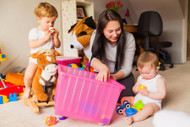5 Household Choking Hazards You May Have Missed
Nov 8th 2024
Parents know that when you welcome a new little family member into your home, there’s no such thing as too much preparation. Still, despite all our best baby-proofing efforts, some things slip under the parental radar—and many of those things are tiny! We’re talking “loose change and pen caps” small. We’re talking about household choking hazards.
Choking is one of the leading causes of death among children, especially toddlers age 3 or younger, according to the American Academy of Pediatrics. It’s no secret that kids at this age love to put everything into their mouths. Because a child’s windpipe is much narrower than an adult’s, the risk of choking is much higher.
Here, we’ve put together a list of some important choking hazards for children, aside from food, that you may have missed. We also want to introduce a solution we believe should be in every family home for choking emergencies.
Choking Hazards to Check
A thorough check of your home is critical once your baby starts toddling around and grabbing every item he or she can get those tiny hands on. Look for these common baby and toddler choking hazards:
- Loose change, pens and other “pocket stuff”: Do you have a spot by the door where you drop keys, gum wrappers and other pocket items when you come in? Does Dad always put his loose change on the coffee table? Are there pens here and there? It’s time to find a secure home for all those little items that we tend to put down wherever. The next time you empty your pockets, do it with purpose.
- Decorations and furniture: A surprising amount of home décor items contain little choking hazards, from a planter with pebbles to your refrigerator magnets. Check your furniture for loose buttons and appliances for loose parts, as well.
- Drawers: Little ones love to open drawers, as many parents know all too well. It may be time to pick up some child safety locks for bathroom drawers, junk drawers and Mom’s makeup vanity.
- Balloons: Deflated balloons are one of the most fatal choking hazards, according to the Consumer Product Safety Commissions. Kids can’t seem to resist putting balloons in their mouths, sometimes while trying to blow them up or often just playing.
- Big-sibling toys: After the phase where kids put everything in their mouths comes the age where all of their toys have a million tiny parts. (plastic toy building bricks and marbles, we mean you!) Soon, baby number two or three comes along, and the amount of choking hazards in the home has increased drastically. Try to get older children involved in the cleanup effort by educating them about why their toys are a danger to their younger siblings.
BONUS TIP: Remember to check for these hazards frequently. Baby-proofing is not a one-time thing; it’s daily vigilance.
A Further Solution: The Dechoker
Keeping all those little hazards out of the home is a constant challenge, but there’s also something we recommend all parents keep in the home: the Dechoker.
No matter how vigilant you are as a parent, the risk of a baby or toddler choking will remain. Our easy-to-use first aid device can unblock a child’s airway quickly in an unexpected emergency, when time is critical. Appropriate for children age 12 months to 3 years, the Dechoker for toddlers can help you be prepared and offer you peace of mind as a loving parent.
Learn more about how the Dechoker works and why it’s a smart choice for your family’s safety.

